
USS Hope was a 19th-century wooden yacht schooner, designed and built in 1861 by Henry Steers for Captain Thomas B. Ives of Providence, Rhode Island. She was acquired by the Union Navy during the American Civil War. She was placed into service as a gunboat assigned to support the fleet blockading the ports of the Confederate States of America. However, at times, Hope was assigned extra tasks, such as that of a dispatch boat, supply runner and salvage ship. She was a pilot boat from 1866 to 1891 and in 1891 she was replaced by the Herman Oelrichs, when the Hope was wrecked ashore the Sandy Hook Point.
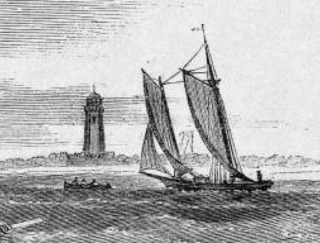
The Ellwood Walter, No. 7 was a 19th-century Sandy Hook pilot boat built in 1853 by Edward F. Williams at Greenpoint, Brooklyn to replace the pilot boat Yankee, which was lost in December 1852. The schooner was used to pilot vessels to and from the Port of New York. She was replaced by the Edmund Driggs, No. 7, in 1864.

The Columbia was a 19th-century pilot boat built C. & R. Poillon shipyard in 1879 for Sandy Hook and New York pilots that owned the Isaac Webb, which was lost off Quonochontaug Beach, Long Island in July 1879. She was run down by the Guion Line steamer SS Alaska in 1883. A second pilot-boat, also named Columbia, was built by Ambrose A. Martin at East Boston in 1894 that had a unique sppon bow and was extremely fast. She was thrown ashore in the great Portland Gale, and remained on the Sand Hills beach in Scituate, Massachusetts for over thirty years as a marine curiosity. The Louise No. 2 replaced the ill-fated Columbia.

The America, No. 21 was a 19th-century pilot boat built in 1880 for the New York City and Sandy Hook Pilots. She was a replacement for the William H. Aspinwall, No. 21, that was lost off Point Judith, Rhode Island in 1880. She weathered the Great Blizzard of 1888. In the time of steam, the America was sold in 1896 by the New York Pilots. A new pilot-boat America was built in 1897 for Captain James H. Reid of Boston and designed from the line drawings by Thomas F. McManus of Boston. After serving 21 years in the Boston Pilots' Association, the America was sold to David W. Simpson of Boston in 1918.
The David T. Leahy was a 19th-century two-masted pilot boat schooner, built in 1890 at the C. & R. Poillon shipyard in New York City. She was named in honor of David T. Leahy, a wealthy woolen merchant. She was said to be the fastest boat in the New York and New Jersey fleet. In 1899, the David T. Leahy was renamed the James Gordon Bennett when the pilots consolidated their business. She sank off Sandy Hook when the German Atlas Line steamship Alene hit her in 1901.

The Caprice was a 19th-century Sandy Hook pilot boat built in 1871 by Brown & Lovell in East Boston, Massachusetts for Peter McEnany and other New York pilots. In 1876, she was run down and sank, off Bay Ridge, Brooklyn, by the steamship New Orleans. She was raised and was one of the pilot boats that survived the Great Blizzard of 1888. The Caprice was last reported sailing off the coast of New York in 1891.

The David Carll was a 19th-century pilot boat, built in 1885 at the David Carll shipyard in City Island, New York. She was named in honor of David Carll, a well-known City Island shipbuilder. The David Carll was considered to be among the fastest schooners in the fleet. She was built to replace the Mary E. Fish that was run down and sank by the schooner Frank Harrington in 1885. She was one of the pilot boats that survived the Great Blizzard of 1888. The David Carll was lost at sea in 1893.
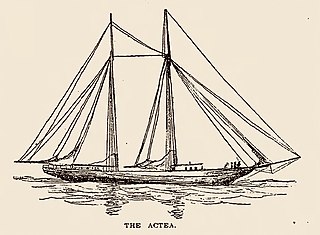
The Actaea, or Actea, was a 19th-century Boston yacht built in 1880 by Weld and David Clark of Kennebunk, Maine for David Sears, Jr., of Montgomery Sears of Boston. She was purchased by a group of New York Sandy Hook Pilots in 1890. She was one of the largest and fastest pilot boats in the fleet. In the age of steam, the Actaea was sold in 1896 to John J. Phelps of the New York Yacht Club and used as a pleasure yacht.
Augustus Van Pelt was a 19th-century New York Sandy Hook maritime pilot. He was one of the oldest and most famous Sandy Hook pilots. He was captain of the pilot boat Isaac Webb, for 19 years. His son, Frank P. Van Pelt was also a well-known Sandy Hook Pilot.
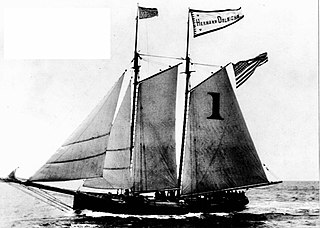
The Hermann Oelrichs was a 19th-century Sandy Hook Pilot boat, built in 1894 by Moses Adams at Essex, Massachusetts for a group of New York Pilots. She helped transport New York City maritime pilots between inbound or outbound ships coming into the New York Harbor. The Herman Oelrichs was said to be the fastest of the New York pilot fleet. She was built to replace the pilot boat Hope, that was wrecked in 1890.

The Mary E. Fish was a 19th-century Sandy Hook pilot boat, built at the Edward F. Williams shipyard of Greenpoint, Brooklyn in 1861 for Richard Brown and the New York Pilots. She was built to replace the Mary Taylor. The Fish was hit and sank by the schooner Frank Harrington in 1885 and replaced by the David Carll.

Charlotte Webb was a 19th-century New York City pilot boat built in 1865 at the Webb & Bell shipyard to take the place of the James Funk, that was destroyed by the rebel Tallahassee during the Civil War. She survived the Great Blizzard of 1888, but was run down by the French steamship La Normandie in 1889. She was replaced by the pilot boat George H. Warren.
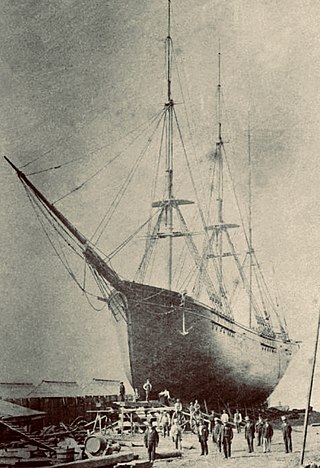
Edward Francis Williams, was a 19th-century shipbuilder. He apprenticed under his father Jabez Williams. Edward F. Williams built his own shipyard, building clipper ships and eleven Sandy Hook pilot boats, some of the finest boats in the fleet. He was the first president of the Greenpoint Savings Bank. Williams died in New Providence, New Jersey, in 1902.

The William H. Bateman, a.k.a. Commodore Bateman, was a 19th-century Sandy Hook pilot boat built in 1888 at the C. & R. Poillon shipyard in south Brooklyn. She was replaced the pilot-boat Phantom that was lost in the Great Blizzard of 1888. She was run down and sank by the Hamburg steamship Suevia in 1889.
The Yankee was a 19th-century Sandy Hook pilot boat built by Holbrook & Adams of Boston in 1848. The schooner was sold to New York pilots and used to pilot vessels to and from the Port of New York. In 1852 the crew of the Yankee received silver medals from the Massachusetts Humane Society for rescuing the captain and mate of the schooner Reaper. The Yankee struck an old wreck and sank 35 miles east of Sandy Hook in 1852. The Ellwood Walter was built to replace her in 1853.

The Virginia was a 19th-century Sandy Hook pilot boat. She came from Savannah to New York City in 1838. In 1840, the Virginia was No. 8 in the list of only eight pilot boats in the New York fleet. She went ashore in 1860 and was replaced by the pilot boat William H. Aspinwall in 1861.

The George H. Warren was a 19th-century pilot boat built in 1882 by Porter Keene at Weymouth, Massachusetts, to replace the Edwin Forrest, No. 4, which was sold to the Pensacola, Florida pilots. The George H. Warren, originally belonged to the Boston pilot fleet but in 1889, she was purchase by a group of New York pilots. She and her crew were lost in the great blizzard of 1895.

Jacob Samson Ellis, was a 19th-century prominent shipbuilder in Tottenville, Staten Island. He had a large successful shipyard business for over thirty years, with a reputation for his skill in designing vessels. Ellis died in Tottenville in 1902. His son, Hampton C. Ellis, continued with the shipyard constructing boats through the 1920s.
Walter Brewer was a 19th-century American harbor pilot who guided large vessels into and out of New York Harbor as a Sandy Hook pilot. He was part owner of the pilot boats Virginia, William H. Aspinwall and the America, of the New York fleet.
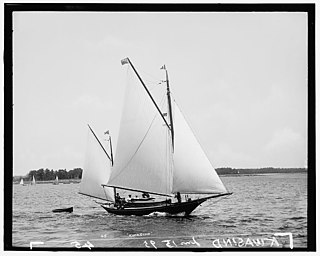
Elbridge T. Gerry was a 19th-century New York Sandy Hook pilot boat built in 1888 at the Robinson & Waterhouse shipyard in City Island, Bronx. She was named in honor of Elbridge Thomas Gerry, a commodore of the New York Yacht Club. She served as a pilot boat from 1888 to 1896, when she was sold for offshore yachting cruises. Her name was changed to Kwasind, after the strongman in Henry Wadsworth Longfellow's Song of Hiawatha.

















